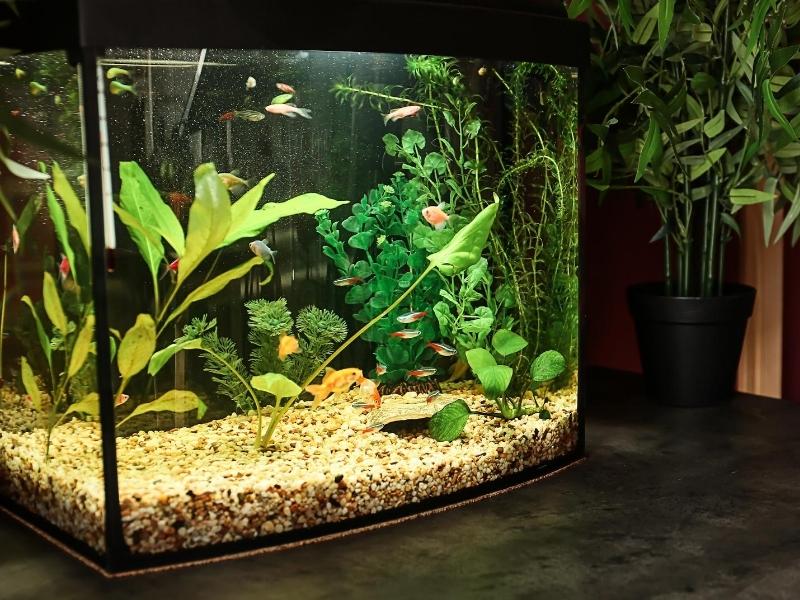Looking for easy, low-maintenance pets that don’t require too much of your time to care for? While fish are among the easiest pets to take care of, keeping your fish healthy means properly maintaining an aquarium. This requires considerably more add-ons than a simple fishbowl.
New fish owners often find taking care of a fish tank a bit overwhelming. But if done right, an aquarium brings tranquility and entertainment to even the smallest of apartments.
If you want an aquarium in your home but don’t know where to begin, here are eight essentials for putting together a great aquarium for your fish.
Aquarium Essentials for Healthy Fish

1. The Right Tank
The size of the tank you choose depends on the number of fish you plan to house. Experts suggest that allocating one gallon per inch of fish is ideal. However, some schools of fish like the goldfish will need more space while betas will need less.
The design and overall quality of the tank must also fit your lifestyle. If you’re short on space, tanks come in all different shapes and sizes. The most popular tanks are made of glass or acrylic, with acrylic being lighter and less breakable. Make sure to have a sturdy place to set your fish tank, as each gallon of capacity translates into 10 pounds of weight.
2. Plants
Aquatic plants are a great choice for a freshwater aquarium. Not only do they provide plenty of decoration, but they also act as natural filters to remove ammonia, nitrite, and nitrate from the water. Plus, fish love to hide in them while some species nibble on them!
Choosing the best low light aquarium plants will save you a fair bit of electricity costs.
3. Substrate
Substrate means a natural covering for the bottom of your fish tank. If you opt for live plants as decoration, they’ll need a substrate where their roots can grow in. Otherwise, polished stones or gravel make an excellent choice.
Substrate not only improves the aesthetic of your aquarium, but it also provides an extra surface area to encourage the growth of beneficial bacteria in the tank.
3. Lighting
Your chosen light source will both illuminate your tank and provide vital energy for any photosynthesizers in the tank’s ecosystem.
Many tanks come with lighting built into the cover, but others offer different lighting options. Fluorescent and LED bulbs are great options for beginners, as they’ll save on energy costs and don’t heat up the water too much. Your aquarium will need one to two watts of lighting per gallon, or up to five watts per gallon for an aquarium with plants.
4. Filter
A filter removes toxins, introduces beneficial microorganisms, and makes an aquarium suitable for the fish. The best quality filters offer a combination of mechanical, chemical, and biological filtration systems.
Choose a filter based on the size and population of your aquarium by looking at the filter’s GPH (gallon-per-hour) flow rate. On average, your filter must clean the water in your tank three to five times an hour.
5. Heater
Aquatic ecosystems, especially those containing tropical fish, are highly sensitive to temperature change. For this option, you need a heater to set your aquarium’s water temperature unless your house is a constant 74 to 80 degrees Fahrenheit year-round.
A submersible water heater should be easy to read and adjust and should provide three to five watts per gallon depending upon aquarium size. A thermometer comes in handy to help keep an eye on your aquarium’s temperature.
6. Air Pump
Depending on the species of fish your aquarium houses, you may need more water flow. An air pump helps oxygenate the water in your aquarium and keep the water a more even temperature.
7. Water Conditioner
Before you put your fish into your tank, you must condition the water. Tap water is harsh and needs a delicate balance of minerals and bacteria to foster healthy fish.
However, you can use a water conditioner to dechlorinate it and remove harmful heavy metals. Some brands of water conditioners also introduce helpful bacteria in the water. Additionally, it’s important to recondition your tank after every monthly water change.
8. Aquarium Test Strips
To ensure that your aquarium remains a healthy, well-functioning ecosystem, you should test your water regularly. These tests should measure ammonia, which can cause toxic build-ups, as well as pH and nitrite. You can also measure the alkalinity, chlorine levels, and hardness of your water.
Consider looking for brands that offer in-tank monitors, but remember to replace them every month or two.
Conclusion
While you need plenty of equipment to get a functioning aquarium up and running, the reward is certainly worth it. Fish are endlessly fun to watch, and the sound of flowing water always brings peace of mind. With these essentials, you can rest assured that your fish are happy and healthy in their new home.
Images Courtesy of Canva.
Other Posts You Might Enjoy:
How to Use Bright Colors in Your Home Design and Furniture
This Is How Your Home Plumbing System Works
Where To Buy Quality Furniture Online Without Paying Retail Prices





